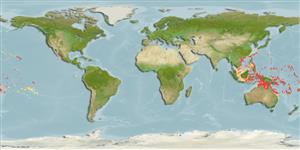Environment: milieu / climate zone / depth range / distribution range
Ecology
Marine; demersal; depth range 1 - 70 m (Ref. 86942). Tropical
Pacific Ocean: Philippines to French Polynesia north to Taiwan, south to Australia.
Size / Weight / Age
Maturity: Lm ? range ? - ? cm
Max length : 3.0 cm TL male/unsexed; (Ref. 90102)
Dorsal spines (total): 6 - 7; Dorsal soft rays (total): 9; Anal spines: 1; Anal soft rays: 7 - 9. Characterized by orange red to yellowish body color, sometimes red on anterior head; elongate and filamentous second dorsal spine; all pectoral rays unbranched; fifth pelvic ray branched, 50-60% length of fourth ray; longitudinal scale series 23-24; predorsal scales 5-7; cheek without scales; upper opercle with 2-3 cycloid scales; depth of body about 3.9-4.2 in SL (Ref. 90102).
Benthic in crevices of coral rock walls, reefs, and on sand/rubble bottoms (Ref. 58302).
Life cycle and mating behavior
Maturities | Reproduction | Spawnings | Egg(s) | Fecundities | Larvae
Eschmeyer, W.N. (ed.), 2003. Catalog of fishes. Updated database version of March 2003. Catalog databases as made available to FishBase in March 2003. (Ref. 46206)
IUCN Red List Status (Ref. 130435)
Threat to humans
Harmless
Human uses
Tools
Special reports
Download XML
Internet sources
Estimates based on models
Preferred temperature (Ref.
123201): 25.2 - 28.9, mean 27.6 °C (based on 362 cells).
Phylogenetic diversity index (Ref.
82804): PD
50 = 0.5000 [Uniqueness, from 0.5 = low to 2.0 = high].
Bayesian length-weight: a=0.00708 (0.00333 - 0.01504), b=3.09 (2.92 - 3.26), in cm total length, based on LWR estimates for this (Sub)family-body shape (Ref.
93245).
Resilience (Ref.
120179): High, minimum population doubling time less than 15 months (Preliminary K or Fecundity.).
Fishing Vulnerability (Ref.
59153): Low vulnerability (10 of 100).
